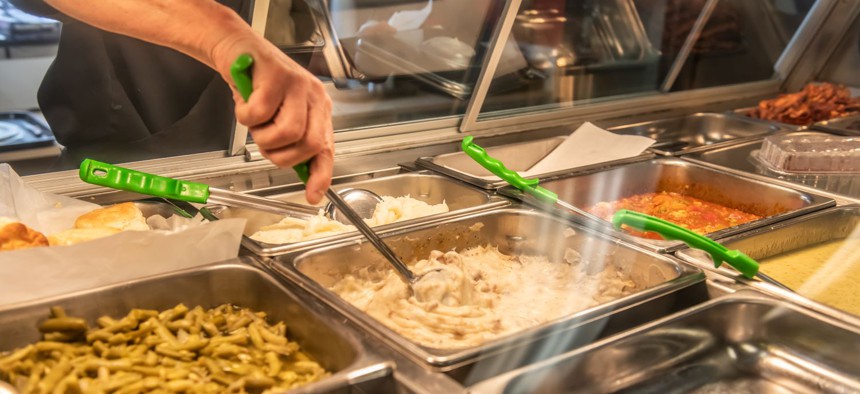State looks to expand food assistance program to restaurants

Melodie Yvonne/GettyImages
Nevada's Restaurant Meals Program would allow people 60 or older, those who are disabled and people experiencing homelessness enrolled in SNAP to buy meals at participating restaurants.
This article first appeared in the Nevada Current. Read the original story.
The Nevada Division of Welfare and Supportive Services is looking to implement a meal program that allows unhoused folks and people with disabilities to use food assistance benefits at partnering restaurants.
The proposal is in its early stages and part of several efforts outlined at Monday’s Interim Committee on Health and Human Services to address food insecurity across the state.
Data provided to state lawmakers by the Division of Public and Behavioral Health within the Department of Health and Human Services showed 13% of the state’s population faced food insecurity and struggled with obtaining enough to eat in 2021.
While Black residents make up about 11% of the state population, they are disproportionately affected by food insecurity at 21%.
There are programs the department oversees to help people pay for food, such as Supplemental Nutrition Assistance Program or SNAP, formally known as food stamps.
“We know there are a lot of people who don’t have a home or a place to cook food,” said Kelly Cantrelle, the deputy administrator for the Division of Welfare and Supportive Services. “There are a lot of seniors or disabled individuals who maybe can’t cook for themselves.”
The Restaurant Meals Program, if established, would allow people 60 or older, those who are disabled and people experiencing homelessness enrolled in SNAP to buy meals at participating restaurants.
Nine states operate a restaurant meal program, according to the U.S. Department of Agriculture’s Food and Nutrition Service.
“One of the reasons the program isn’t as popular as you may think is because we’ve seen a lot of states roll this out with a lot of fast food restaurants participating,” Cantrelle said. “There is an argument that it’s not healthy food.”
She said the program is only in its infancy and didn’t have a timetable for when it could be rolled out. The division is working with the UNR’s Extension Education program to identify more restaurants that offer nutritious options.
“We are in our infancy stage so there is a lot we don’t know yet,” Cantrelle said.
The division is also requesting a waiver from the USDA’s Food and Nutrition Services in order to start being able to complete SNAP applications over the phone. Right now, they don’t have the needed tools to collect and store signatures from phone calls.
Once implemented, she said the move “will help with individuals who can’t get to the office,” including those who are disabled or elderly.
There are also issues with connecting eligible people to other types of assistance, such as Women, Infants and Children, or WIC, programs. WIC provides supplemental food and nutrition resources specifically for low-income women who are pregnant or have children up to 5.
Sarah Rogers with the Division of Public and Behavioral Health said around 105,000 current SNAP recipients are eligible for WIC as well, but only about half of them are taking advantage of the assistance.
There were 54,059 WIC recipients in 2023, an increase from 51,073 in 2022, lawmakers were told Monday.
In total, the division “estimated that 116,000 families in Nevada qualify for WIC,” she said.
For those using SNAP, nearly 87% use it for infant formula. Another 79% put it toward fruits and vegetables.
“If you can use WIC for a lot of that formula, then maybe you could use SNAP benefits for other food you need,” Cantrelle said.
Democratic state Sen. Fabian Doñate said the stigmatization attached to receiving benefits can lead to eligible people declining assistance they need.
He asked whether it’s possible to enroll prospective clients the state knows are eligible and “if they choose to disenroll that’s up to them.”
The division, Cantrelle said, does automatically refer women with children under 5 who use SNAP benefits to the WIC program.
“We did learn a while back that when we do that and (women) reach out they say, ‘we weren’t interested in that’ or ‘we didn’t ask for that,’ ” she said. “We don’t know why exactly. We just know better if we ask individuals rather than send the referral.”
The department is implementing a training program to ensure staff understand income limits and requirements for WIC and to figure out ways to “effectively close that gap and make sure all the children who are eligible receive the benefits from WIC,” she said.
Nevada Current is part of States Newsroom, a nonprofit news network supported by grants and a coalition of donors as a 501c(3) public charity. Nevada Current maintains editorial independence.
NEXT STORY: Emergency alert: States confront EMS shortages





